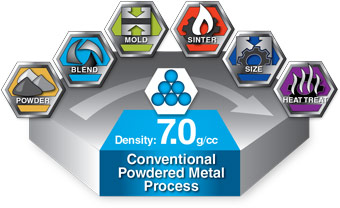Powdered Metal Capabilities
Built-in Efficiency, Proven Technology
Powdered metal manufacturing is an efficient, cost-effective method to produce high-strength parts for many industries. The basic principles have been successful for over 100 years, and frequent innovations at Keystone and throughout the industry continue to expand potential applications.
By eliminating or minimizing machining, the powdered metal process results in a more efficient use of materials, labor, energy, and capital compared to cast or wrought parts. Typical material utilization of conventional PM is approximately 97%.
Powdered metal also offers unparalleled versatility to design for physical and mechanical properties through combinations of metals and processing steps. As a comprehensive service provider with extensive capabilities, we will help you with product design and material selection. Our goal is to optimize the plan for whichever manufacturing process meets your requirements:
Conventional

The primary method of powdered metallurgy involves three steps: material blending, compressing, and sintering. Common products include bushings, gears, and sprockets used in appliances, automobiles, and outdoor power equipment.
- We create a precise blend of powders and binder material that will achieve the desired final properties.
- The powder feeds into a die cavity and is pressed into shape, forming a solid but fragile "green" part.
- The part moves to the sintering furnace, which heats and cools the part at controlled temperatures to create the final metallurgical bond.
A sintered, inspected part is ready for use, or it can undergo secondary operations.
Ultra-High Density (UHD)
The ultra-high density process results in higher impact resistance and better performance under load. Bevel gears, parking gears, spur gears, and transmission sprockets are excellent UHD candidates.
- The material blending and molding steps are the same as in conventional PM.
- The sintering procedure occurs at lower temperatures to avoid a full metallurgical bond.
- A sizing operation further compresses the presintered part.
- Another sintering operation at full temperature completes the bond.
Secondary operations are also possible for UHD parts.
Powder Forging or "Hot Forming"
Keystone is a leader in powder forging capabilities. We are among a select few to offer the process, and we are the world's first company to put a powder forged helical pinion into production.
- As in conventional PM, the powder is blended, compressed, and sintered.
- The sintered part is heated to forging temperature.
- The part transfers to a forging die and is struck again to reach its final shape and density.
Resulting in theoretically dense (7.8 g/cc) parts with properties identical or superior to wrought—at a lower cost—powder forging has the potential to replace a wide variety of machined parts in every industry.
For any process, the upfront work of selecting the proper material system, design features, and production plan is vital. Take the time to discuss your product requirements with our experienced engineering team. Together, we will define the materials and processes most beneficial for your application needs and bottom line.
Click here to contact us and see how our powdered metal capabilities can improve your product lines.

